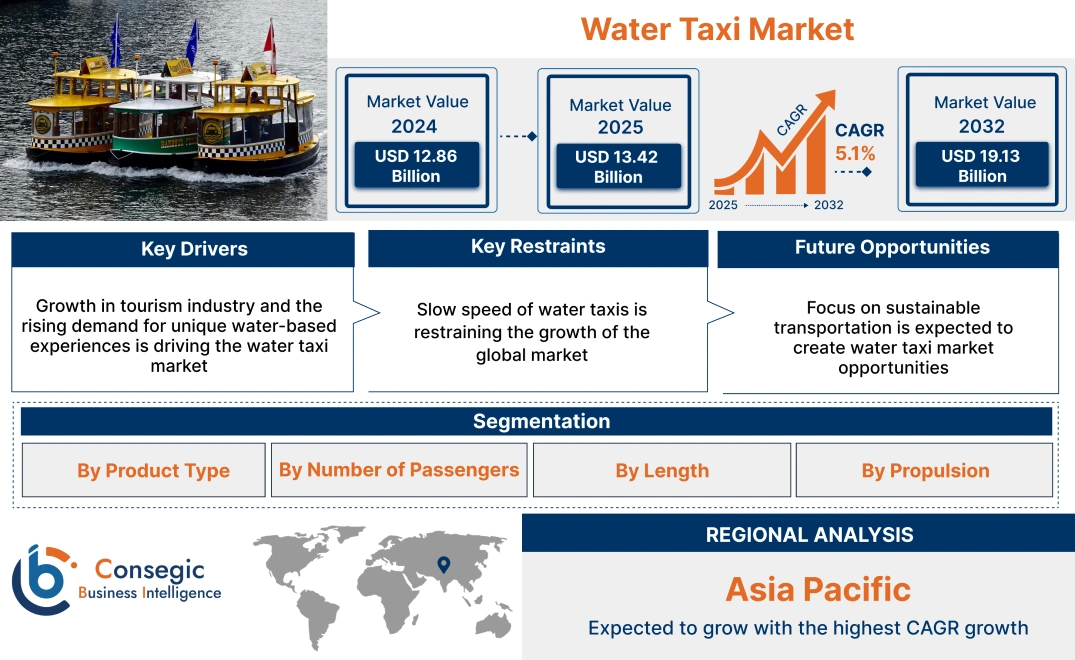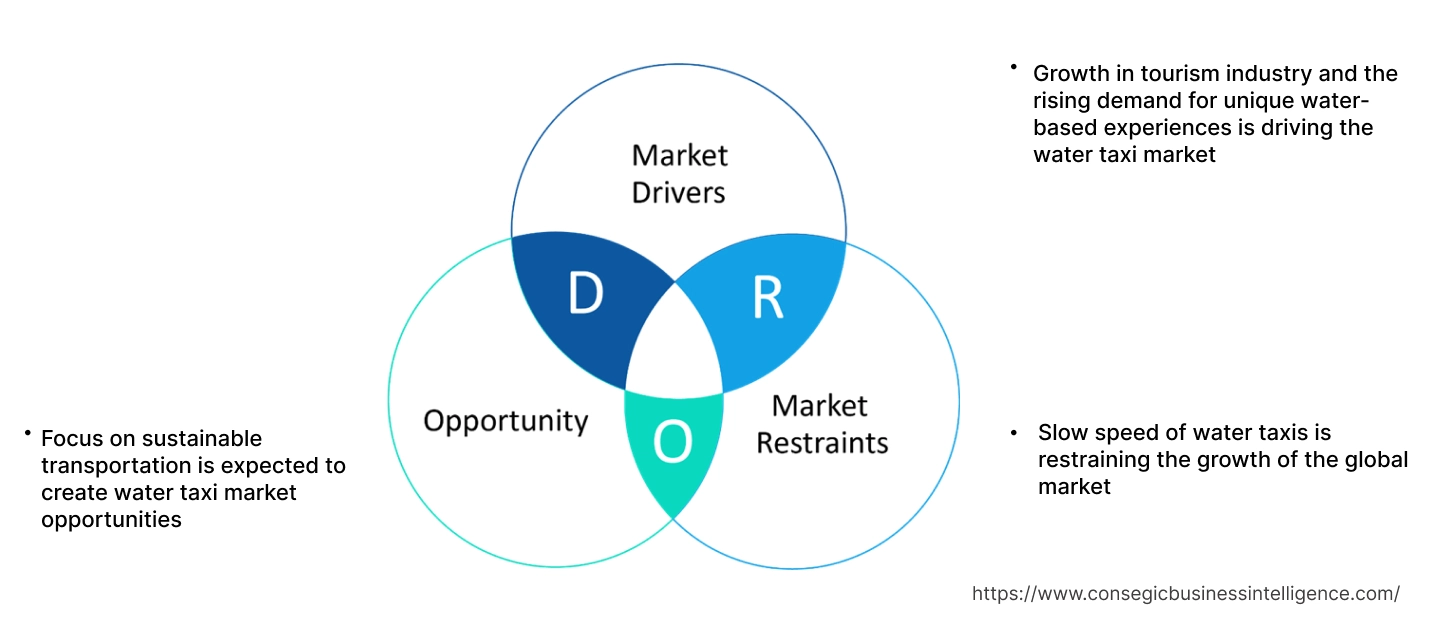- Summary
- Table Of Content
- Methodology
Water Taxi Market Size:
Water Taxi Market Size is estimated to reach over USD 19.13 Billion by 2032 from a value of USD 12.86 Billion in 2024 and is projected to grow by USD 13.42 Billion in 2025, growing at a CAGR of 5.1% from 2025 to 2032.
Water Taxi Market Scope & Overview:
Water taxis offer transportation across water bodies within cities or tourist destinations, using boats or other watercraft to ferry passengers between various points. It offers a convenient and eco-friendly alternative to traditional transport, especially in crowded urban areas and popular tourist spots. Additionally, with the increasing demand for sustainable travel options and unique travel experiences, water taxis are an ideal option.
Key Drivers:
Growth in tourism industry and the rising demand for unique water-based experiences is driving the water taxi market
Expanding tourism sector plays a significant role in driving the demand for water taxis, particularly in cities with coastlines, rivers, and other waterfronts. Water taxis offer an attractive solution by allowing visitors to explore waterfront areas in a way that combines convenience with scenic beauty. These water-based transportation options allow tourists to enjoy views of the city, enhancing the overall travel experience.
- For instance, according to World Travel & Tourism Council, in 2023, the Travel & Tourism sector saw a significant recovery, contributing 9.1% to global GDP, marking a notable increase of 23.2% compared to 2022.
Thus, as per the analysis, the expansion in maritime tourism is driving the water taxi market share.
Key Restraints:
Slow speed of water taxis is restraining the growth of the global market
Water taxis travel at slower speeds compared to other modes of transport, limiting their efficiency to cover long distances. The slower speed increases the overall travel time, which makes water taxis less efficient in terms of scheduling and customer satisfaction. Additionally, the availability of alternatives that provide convenience of faster and more direct routes outweighs the slower speed of water taxis, thus hampering the global water taxis market growth.
Thus, as per the market analysis, slower speed is impeding the global water taxi market growth.
Future Opportunities :
Focus on sustainable transportation is expected to create water taxi market opportunities
The global shift towards sustainable transportation solutions is expected to create a favorable environment for the growth of water taxis. As governments and consumers prioritize eco-friendly options, water taxis, with their low carbon emissions, are gaining traction. Taxis that utilize electric or hybrid technologies not only reduce emissions but also align with global sustainability goals. Therefore, use of electric or hybrid water taxis is projected to attract environmentally conscious consumers and contribute positively to urban ecosystems, hence becoming an ideal choice.
- For instance, E-lixr is shifting its business strategy to become the first operator of all-electric vessels in the United States which marks a move toward sustainability and innovation in the maritime transport sector. The company aims to replace traditional fuel-powered boats with fully electric alternatives, offering a cleaner, greener way to navigate waterways.
Hence, based on the analysis the shift towards sustainable transportation is expected to present significant water taxi market opportunities.
Water Taxi Market Segmental Analysis :
By Product Type:
Based on the product type, the market is classified into cruise, ferries, sail boats, yachts, and others.
Trends in the Product Type:
- The growing trend towards the integration of solar panels into sail designs to provide auxiliary power to onboard systems.
- Cruise boats in the water taxi market are integrating more luxury amenities including onboard dining, climate control and entertainment systems to attract premium customers.
The ferries segment accounted for the largest revenue share of 40.6% in 2024
- Ferries are designed to carry a large number of passengers, suitable for high-volume transportation needs, such as commuting between mainland and islands or transporting tourists to popular destinations.
- In many regions, ferry services receive government support and subsidies, which helps to keep fares affordable and maintain operations.
- Also, the emergence of electric ferries offering sustainable transportation is boosting the water taxi market demand.
- For instance, in December 2024, the San Francisco Bay Ferry Board of Directors approved the purchase of the first three battery-electric, zero-emission high-speed passenger ferries in the nation from All American Marine Inc. This decision marks a significant step towards a more sustainable and environmentally friendly transportation system in the San Francisco Bay Area.
- Thus, as per the analysis, the aforementioned factors are driving the water taxi market size.
The cruise segment is expected to register the highest CAGR over the forecast period
- Cruises offer an all-inclusive vacation experience, bundling accommodation, meals, entertainment, and shore excursions into a single package, which is highly appealing to travelers.
- Cruises cater to a wide range of interests, with itineraries spanning various regions, from the Caribbean and Mediterranean to the Arctic and Antarctic, allowing travelers to explore multiple destinations.
- Additionally, the cruise sector is constantly investing in new ship construction and port infrastructure, enhancing passenger capacity and improving the overall travel experience.
- For instance, according to CLIA (Cruise Line International Association), cruise industry has recovered strongly, exceeding 10 million passengers since resuming operations in July 2020. With nearly 100% of the fleet back in service and passenger interest mirroring pre-pandemic levels, the industry has proven its ability to navigate challenges.
- Therefore, as per water taxi market analysis, the aforementioned water taxi market trends are expected to continue driving expansion in the coming years.
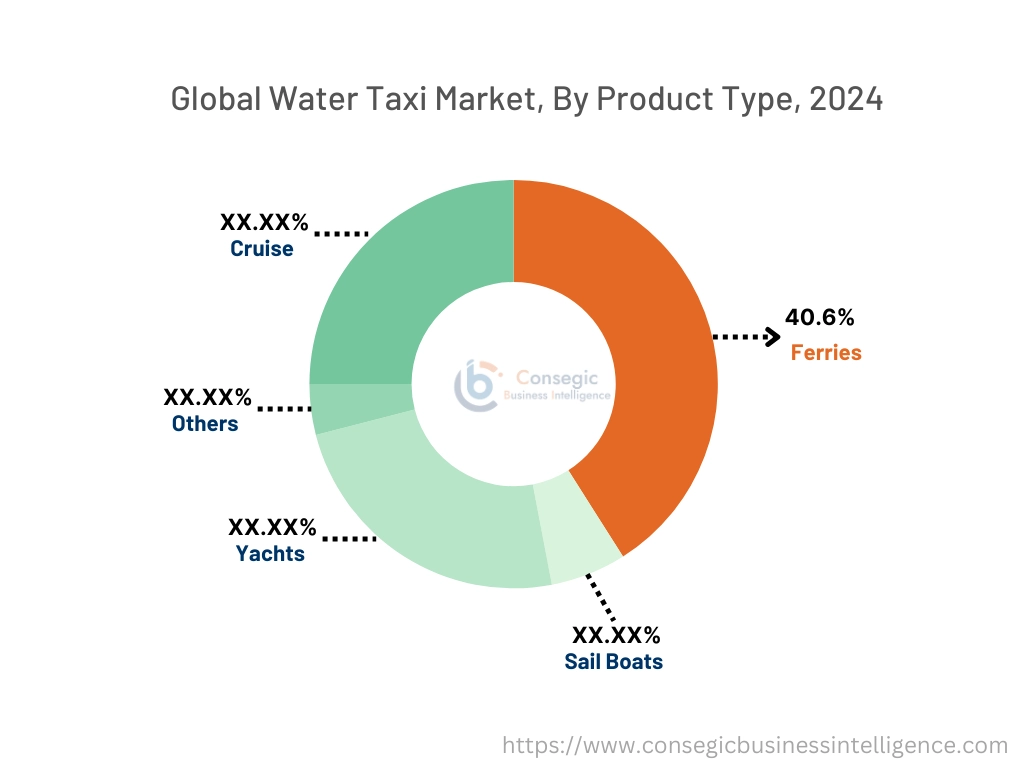
By Number of Passengers:
Based on the number of passengers, the market is segmented into Upto 12 and Above 12.
Trends in the Number of Passengers:
- Small-capacity water taxis are ideal for private charters, VIP transport and luxury tourism. Tourists and high net-worth individuals prefer exclusive rides.
- Small passenger capacity taxis are ideal for electrification due to lower power requirements.
The above 12 segment accounted for the largest revenue share in 2024 and is also projected to witness the fastest CAGR
- Water taxis are designed to carry more than 12 passengers, such as larger ferries and tour boats, accommodate larger groups and transport a greater number of people per trip. This translates to higher revenue potential compared to smaller water taxis with limited passenger capacity.
- Larger water taxis are preferred for group bookings, charters, and organized tours and generate substantial revenue, which in turn is driving the market trend.
- Larger vessels are better equipped for longer routes and services, such as inter-island travel or longer sightseeing tours, which can command higher fares.
- Larger water taxis often operate more efficiently, transporting a greater number of passengers per trip and reducing operational costs per passenger.
- Overall, the factors contribute to the "Above 12" segment's dominance, which in turn, is increasing the water taxi market size.
By Length:
Based on the Length, the market is classified into Upto 10 m and above 10 m.
Trends in the Length:
- Short taxis are ideal for small groups, eco-tourism, and recreational purposes including island-hopping or sunset cruises.
- Short taxis are made using lightweight and durable materials like aluminum and composites to improve fuel efficiency.
Above 10 m accounted for the largest revenue share in the year 2024 and is also projected to witness the fastest growth
- Larger vessels (over 10 meters) generally have significantly higher passenger capacities compared to smaller ones, translating to higher revenue potential per trip.
- Larger vessels are better suited for longer distances and open water travel, enabling them to serve routes connecting distant destinations and offer more extensive tours.
- Many larger vessels cater to the luxury travel market, offering premium amenities, exclusive services, and higher ticket prices.
- Additionally, larger vessels can accommodate a wider range of services, such as dining, entertainment, and overnight accommodations, further increasing revenue streams.
- Therefore, the aforementioned factors are contributing significantly in accelerating the water taxi market share.
By Propulsion:
Based on the propulsion, the market is classified into battery powered or electric, diesel, and hybrid.
Trends in the Propulsion:
- Stringent government policies on reducing carbon emissions are driving the shift toward fully electric water taxis.
- Cities like Amsterdam, Venice, and Stockholm are adopting electric water taxis to reduce air and water pollution.
The diesel segment accounted for the largest revenue share in 2024
- Diesel engines offer high power-to-weight ratios, suitable for larger and faster water taxis that need to cover longer distances. This is particularly important for routes connecting distant destinations or operating in challenging conditions.
- Diesel fuel is generally more affordable than other options like gasoline, leading to lower operating costs for water taxi operators.
- Diesel engines are widely available in various sizes and configurations, suitable for different types of water taxis and operating requirements.
- For instance, The Golden Gate Ferry, originally powered by gas turbines, underwent a conversion to diesel propulsion in San Diego. This switch resulted in significant cost savings for the ferry service. By transitioning to diesel fuel, the Golden Gate Ferry achieved a remarkable 60% reduction in fuel expenses. Furthermore, the conversion led to a substantial decrease in annual maintenance costs, amounting to a substantial USD 300,000 savings.
- Thus, as per the analysis, the aforementioned factors are driving the water taxi market demand.
The battery powered or electric segment is expected to register the highest CAGR over the forecast period
- Many governments are actively supporting the electric vehicle market through subsidies, tax breaks, and the development of charging infrastructure.
- Electric vehicles offer superior performance in terms of acceleration, handling, and quietness, making them increasingly attractive to drivers.
- Rapid advancements in battery technology are resulting in increased energy density, longer range, and faster charging times, making electric vehicles more practical and appealing to consumers.
- For instance, August 2022, Siemens Energy introduced whisper-quiet electric propulsion systems in the Bastø Electric. These systems can drastically cut fuel consumption and emissions by up to 90%, a crucial step towards a more sustainable maritime sector.
- Therefore, as per analysis, the aforementioned water taxi market trends are expected to continue driving expansion in the coming years.
Regional Analysis:
The global water taxi market has been classified by region into North America, Europe, Asia-Pacific, MEA, and Latin America.
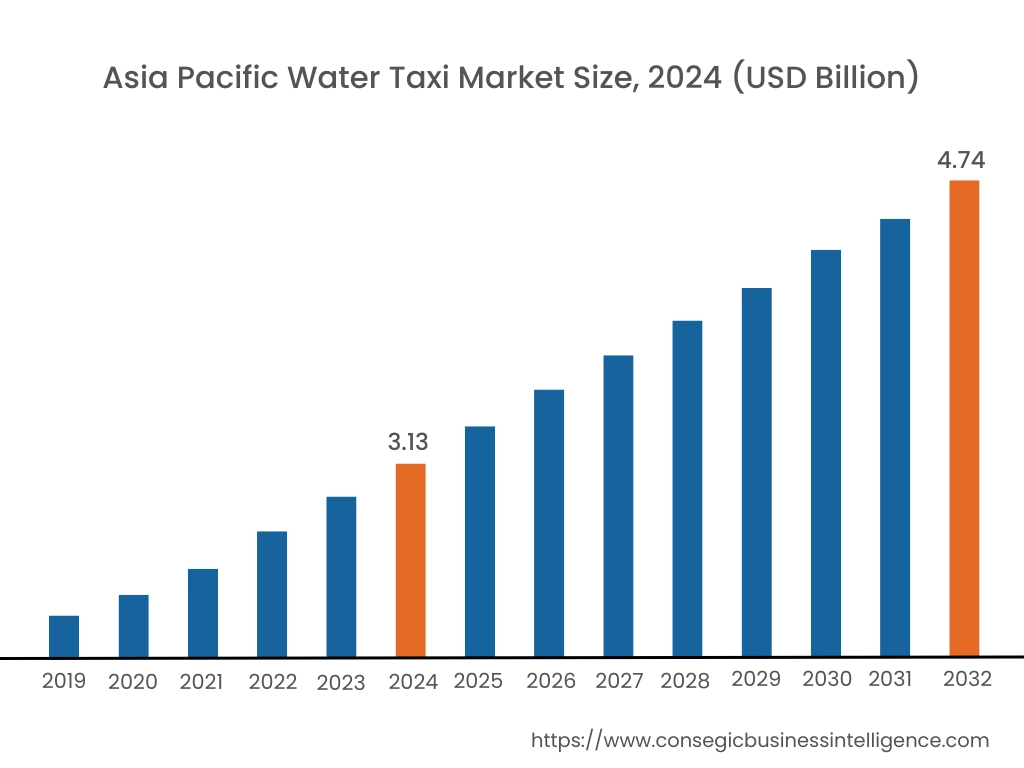
Asia Pacific region was valued at USD 3.13 Billion in 2024. Moreover, it is projected to grow by USD 3.27 Billion in 2025 and reach over USD 4.74 Billion by 2032. Out of these, China accounted for the largest revenue share of 33.4% in 2024.
Many major cities in the region are grappling with increasing traffic congestion on land. Water taxis offer a viable alternative, providing efficient and often scenic transportation routes. In addition, the region is a major tourist destination, with millions of visitors seeking unique experiences. Water taxis offer a novel and exciting way to explore coastal and inland waterways, boosting tourism revenue.
- For instance, Bangkok's Chao Phraya River is a prime example of a thriving water taxi market, serving as a crucial mode of transportation for both locals and tourists. Additionally, Singapore's Marina Bay area has embraced water taxis as a convenient and eco-friendly way to navigate the city's waterfront.
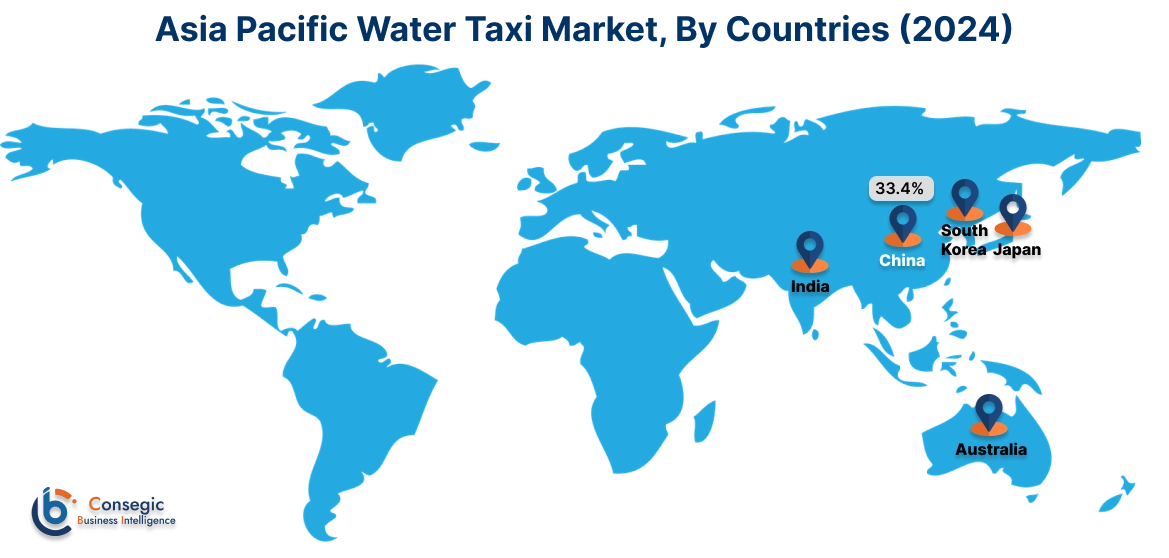
Europe region was valued at USD 4.98 Billion in 2024. Moreover, it is projected to grow by USD 5.20 Billion in 2025 and reach over USD 7.47 Billion by 2032. Europe boasts numerous coastal and inland waterways destinations, attracting millions of tourists annually. These taxis offer a unique and convenient way to explore these areas, contributing to the region's strong tourism appeal. Additionally, many European countries prioritize eco-friendly transportation options. Water taxis, especially electric ones, align with this focus by reducing emissions and noise pollution, ideal for both tourists and locals. Moreover, several European governments actively promote water-based transportation, providing incentives and infrastructure development to encourage the growth of water taxi services.
- For instance, in May 2021, Czech Republic and Germanyv have signed an agreement to ensure and maintain navigation on the Elbe River between Pardubice and Hamburg. The agreement is a significant step towards promoting sustainable and efficient transportation in Europe. By ensuring consistent navigability along the Elbe River, the agreement facilitates the use of this waterway for eco-friendly freight transport, reducing reliance on road and rail transport, which have higher carbon emissions.
As per the water taxi market analysis, Cities like New York, Miami, and Vancouver face increasing traffic congestion, making water taxis an attractive alternative for commuting and tourism. Additionally, rapid urbanization in many Latin America cities is creating a need for efficient and sustainable transportation solutions, making water taxis a viable option. Some governments in the region are actively promoting water-based transportation, providing incentives and infrastructure development for water taxi services. Furthermore, Dubai's iconic waterways and focus on luxury tourism provide a strong foundation for the development of high-end water taxi services. Coastal cities like Cape Town can utilize water taxis for tourism, commuting, and accessing remote areas.
Top Key Players and Market Share Insights:
The market is highly competitive with major players providing water taxi solutions to the national and international markets. Key players are adopting several strategies in research and development (R&D), product innovation, and end-user launches to hold a strong position in the market. Key players in the water taxi industry include-
- Uber Boat by Thames Clippers (UK)
- Water Taxi Miami (US)
- New York Waterway (US)
- San Francisco Bay Ferry (US)
- Hornblower Cruises & Events (US)
- Waterbus (Netherlands)
- BC Ferries (Canada)
- SeaBubbles (France)
- AVM S.p.A. (Italy)
- Big Bus Tours (U.K.)
- Water Taxi Rotterdam (Netherland)
Recent Industry Developments :
Partnerships & Collaborations:
- In March 2023, The Artemis EF-24 Passenger, a 100% electric foiling ferry, has been recognized for its innovation by winning the Commercial Project Award at the Foiling Awards.
Water Taxi Market Report Insights :
| Report Attributes | Report Details |
| Study Timeline | 2019-2032 |
| Market Size in 2032 | USD 19.13 Billion |
| CAGR (2025-2032) | 5.1% |
| By Product Type |
|
| By Number of Passengers |
|
| By Length |
|
| By Propulsion |
|
| By Region |
|
| Key Players |
|
| North America | U.S. Canada Mexico |
| Europe | U.K. Germany France Spain Italy Russia Benelux Rest of Europe |
| APAC | China South Korea Japan India Australia ASEAN Rest of Asia-Pacific |
| Middle East and Africa | GCC Turkey South Africa Rest of MEA |
| LATAM | Brazil Argentina Chile Rest of LATAM |
| Report Coverage |
|
Key Questions Answered in the Report
How big is the Water Taxi market? +
The Water Taxi Market Size is estimated to reach over USD 19.13 Billion by 2032 from a value of USD 12.86 Billion in 2024 and is projected to grow by USD 13.42 Billion in 2025, growing at a CAGR of 5.1% from 2025 to 2032.
What specific segmentation details are covered in the Water Taxi report? +
The Water Taxi report includes specific segmentation details for product type, number of passengers, length, and propulsion and regions.
Which is the fastest segment anticipated to impact the market growth? +
In the water taxi market, the cruise is the fastest-growing segment during the forecast period.
Who are the major players in the Water Taxi market? +
The key participants in the Water Taxi market are Uber Boat by Thames Clippers (UK), Water Taxi Miami (US), New York Waterway (US), San Francisco Bay Ferry (US), Hornblower Cruises & Events (US), Waterbus (Netherlands), BC Ferries (Canada), SeaBubbles (France), AVM S.p.A. (Italy), Big Bus Tours (U.K.), Water Taxi Rotterdam (Netherland) and Others.
